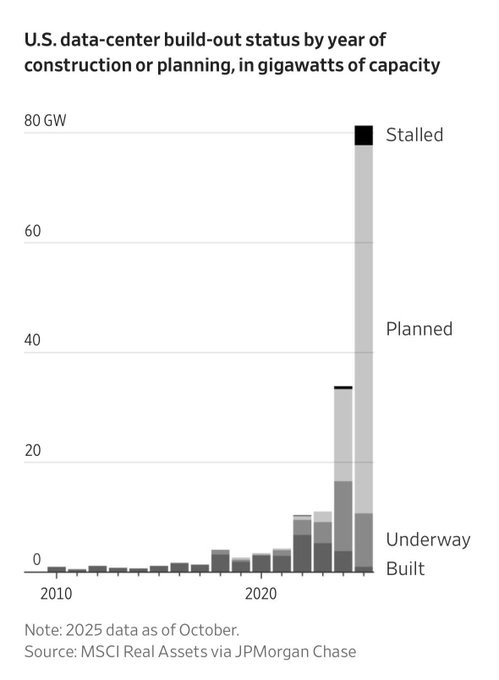NVIDIA expands Microsoft partnership with Blackwell GPUs for AI infrastructure
Investing.com -- For most of the past decade, U.S. data-center additions were small — only a few gigawatts per year. That changes dramatically after about 2020.
Starting around 2021-2022, the bars become much larger as hyperscalers accelerated expansion to meet AI and cloud-computing demand.
- Get premium news and insight, AI stock picks, and deep research tools by upgrading to InvestingPro - get 55% off today 
This chart from JPMorgan shows how much U.S. data-center power capacity (in gigawatts) is either built, under construction, planned, or stalled by year — and it highlights how sharply demand has exploded due to AI.
As you can see, the key takeaway is the spike in planned capacity for 2025. The bar for that year shoots to nearly 80 GW of data-center projects — an unprecedented pipeline.
However, the presence of a small but visible stalled segment indicates that a portion of these projects is already on hold, likely because of land constraints, power shortages, or permitting bottlenecks.
Morgan Stanley warned in a recent client note that the U.S. could face a significant electricity deficit as artificial intelligence build-outs accelerate, with data-center demand at risk of outpacing available power through 2028. The bank said the shortfall could reach about 13 gigawatts of capacity, or roughly a fifth of what the sector is expected to require.
Analysts led by Stephen Byrd said the imbalance could be even larger on a gross basis.
“We project a U.S. power shortfall through 2028 of 44 gigawatts (GW), before considering innovative time-to-power solutions that do not rely on the typical grid interconnection process,” they wrote.
Those alternative approaches, the team added, “could surprise to the upside” and narrow the gap.
The bank tied the potential deficit directly to the breakneck pace of AI infrastructure expansion, describing AI computing demand as “the most important technological shift in modern history.”
It said companies positioned in power, cooling, data-center construction, and grid-adjacent services are now central to that shift, with the “non-linear rate of AI improvement” influencing how a wide range of assets are being valued.
Morgan Stanley’s note adds to a growing chorus of warnings that the U.S. power system is struggling to keep up with soaring data-center plans, underscored by surging forecasts from utilities and grid operators.
At the same time, the chart visually reinforces a core point: AI has triggered a historic boom in U.S. data-center construction, but the system is now hitting constraints that could slow future builds end eventually slow money inflows in AI-focused stocks, which have been the key market driver in recent years.
